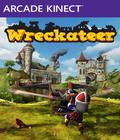Sitting down (OK, standing since it's a Kinect game) to play Wreckateer for the first time is kind of like looking back through a video game time machine. On a conceptual level, Wreckateer shares aspects of many artillery games, though two significant titles stand out from the pack: Smithereens! (Odyssey 2) and Scorched Earth (DOS PC). Both of these titles were brilliant for their time, and Wreckateer updates the core components quite well. Unfortunately, the one aspect that is brand new is also the most persnickety: the motion controls.
One of the first castle-smashing games, Smithereens! tasked players with using a catapult to eliminate their opponent's castle. There was no AI to speak of, as you could only play against another person, but the controls were rock solid, and the voice support was a technological marvel back in 1982. Swap the catapult with a ballista, move the view behind the player character, and render it all in beautiful 3-D, and you've got the basics of Wreckateer.
As a junior apprentice, your task is to help the senior wreckers destroy castles suffering from a goblin infestation. It's easier to level the suckers than clean them out the conventional way. You're limited in the number of shots you can take, so creative use of power-ups and six special shot types is a necessity if you plan on maximizing your score.
The basic shot is just that. It's a metal ball that follows a basic trajectory. What it lacks in power, the basic shot makes up for in steering. Wreckateer allows you to apply "English" to most any shot by slapping the ball with your hands while it's in flight. The basic shot is the easiest to control in this manner and, as such, is good for reaching precision targets.
Other shots include the bomb shot (boom), flying shot (much like a RC plane), the lift shot (allows you to increase altitude in mid-flight), speed shot (instant bullet) and split shot (multi-ball!). Each of these shots is initially launched just like a basic shot. The special powers only take effect when activated by the player.
For example, the speed shot takes off like a bullet when activated. If you can line it up with a series of towers before activation, you can take out an entire row with one shot. If the towers are side by side, then the split shot is the way to go. When activated, the single shot splits into four smaller balls connected by a string. They remain anchored between your hands. Moving your hands allows you to compress the shots or spread them out, as well as angle them as necessary.
All of these fancy shot types are necessary because Wreckateer scores your performance on both destruction and flair. The score multiplier is tied directly to the destruction level. The more you eliminate, the higher your multiplier. Doing well here is usually enough to get a silver medal, but to get golds across the board requires destruction with style.
Performing trick shots, leveling secondary targets (such as homes), triggering a massive crash and nailing a goblin square in the jaw are just some of the actions that earn bonus icons. Each icon adds extra points to your score. In combination with the multiplier, the numbers can really add up.
The final layer of strategy in Wreckateer has to do with the floating targets. Ranging from points to individual use power-ups, these targets provide suggested goals for each level. Hitting one with a shot gets you the immediate bonus, but they often double as setup points for massive destruction. Figuring out the optimal destruction pattern is the most cerebral part of Wreckateer. In some ways, it's almost like a puzzle game.
With a good set of options, solid design and nice visual polish, Wreckateer could have easily been a standout title. Sadly, it is held back by uneven Kinect controls. It's not that the Kinect controls don't work. They do — most of the time. When the controls work, it's awesome. The default motions are intuitive and easy to pick up, making Wreckateer a great game for parties as well as families with young children. When the controls fail, however, they fail both unpredictably and miserably, and that's bound to frustrate score attack players. Sure, you can restart, but it's annoying. Wreckateer is a game that demands precision for high-level play, yet the Kinect simply doesn't allow for it.
In an interesting bid to extend replay, Microsoft is using Wreckateer to launch its Avatar FameStar initiative. FameStar is basically a second set of achievements. Instead of tying into your Gamerscore, the FameStar goals earn fame points that unlock avatar rewards. Oddly, these rewards can be used within the game, but not on the dashboard itself, so you can't really show them off to your friends.
Visually vibrant, solid play mechanics and colorful characters make Wreckateer an attractive game for the casual set, but quirky Kinect controls keep it from greatness. This is the perfect example of a game where Kinect should have been an option, rather than mandatory.
Score: 7.0/10
More articles about Wreckateer











 Wreckateer uses Kinect to put you in control of a massive castle-wrecking ballista. With the help of Wreck and Tinker, travel the land and destroy 60 castles infested with goblins using six magical projectiles.
Wreckateer uses Kinect to put you in control of a massive castle-wrecking ballista. With the help of Wreck and Tinker, travel the land and destroy 60 castles infested with goblins using six magical projectiles.





